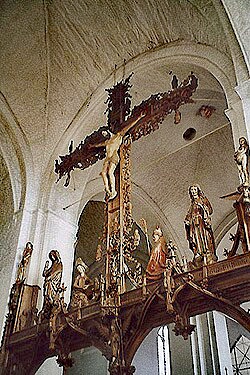Rood
Rood is a term with historical and religious significance, primarily in Christianity. It refers to a cross or crucifix, especially one that is large and placed within or upon an altar screen, known as a rood screen, which separates the nave from the chancel in a church. The term "rood" itself derives from the Old English word "rōd," meaning "pole," but has come to be associated specifically with the crucifixion cross of Jesus Christ.
History and Significance[edit | edit source]
The tradition of placing a rood within a church dates back to the Early Middle Ages in Christian Europe. The rood often included not only the cross but also figures of the Virgin Mary and John the Evangelist, positioned to the sides of Christ. This arrangement is known as a rood group and is a powerful symbol of the Crucifixion, serving as a focal point for Christian worship and devotion.
Rood screens, which supported the rood, became a prominent architectural feature in medieval churches, particularly in England, Wales, and other parts of Europe. These screens, often elaborately carved and decorated, served both a practical and symbolic function, separating the sacred space of the chancel, where the altar is located, from the nave, where the congregation gathers. The rood screen thus symbolized the division between the divine and the earthly, while the rood itself served as a reminder of Christ's sacrifice.
Rood in Modern Times[edit | edit source]
In contemporary Christianity, the use and significance of the rood have evolved. While fewer new churches are built with traditional rood screens, the rood remains an important symbol in many Christian denominations. Modern interpretations of the rood can vary widely, from traditional crucifixes to more abstract representations of the cross, reflecting the diversity of Christian thought and artistic expression.
Cultural Impact[edit | edit source]
Beyond its religious significance, the rood has also influenced art, literature, and cultural traditions. It has been a subject of veneration, artistic inspiration, and scholarly interest throughout the centuries. The rood and rood screens have been central to studies on medieval art and architecture, shedding light on the religious, social, and aesthetic values of the past.
Preservation and Restoration[edit | edit source]
Many historic churches and cathedrals have undertaken efforts to preserve or restore their rood screens and roods, recognizing their cultural and historical value. These projects often involve meticulous research and craftsmanship to maintain the integrity of these ancient artifacts, ensuring that they continue to inspire and educate future generations.
Conclusion[edit | edit source]
The rood remains a potent symbol of Christian faith, embodying themes of sacrifice, redemption, and the intersection of the divine and the human. Its presence in churches serves as a reminder of the central mysteries of Christianity, while its artistic and cultural expressions continue to enrich the human experience.
Search WikiMD
Ad.Tired of being Overweight? Try W8MD's physician weight loss program.
Semaglutide (Ozempic / Wegovy and Tirzepatide (Mounjaro / Zepbound) available.
Advertise on WikiMD
|
WikiMD's Wellness Encyclopedia |
| Let Food Be Thy Medicine Medicine Thy Food - Hippocrates |
Translate this page: - East Asian
中文,
日本,
한국어,
South Asian
हिन्दी,
தமிழ்,
తెలుగు,
Urdu,
ಕನ್ನಡ,
Southeast Asian
Indonesian,
Vietnamese,
Thai,
မြန်မာဘာသာ,
বাংলা
European
español,
Deutsch,
français,
Greek,
português do Brasil,
polski,
română,
русский,
Nederlands,
norsk,
svenska,
suomi,
Italian
Middle Eastern & African
عربى,
Turkish,
Persian,
Hebrew,
Afrikaans,
isiZulu,
Kiswahili,
Other
Bulgarian,
Hungarian,
Czech,
Swedish,
മലയാളം,
मराठी,
ਪੰਜਾਬੀ,
ગુજરાતી,
Portuguese,
Ukrainian
Medical Disclaimer: WikiMD is not a substitute for professional medical advice. The information on WikiMD is provided as an information resource only, may be incorrect, outdated or misleading, and is not to be used or relied on for any diagnostic or treatment purposes. Please consult your health care provider before making any healthcare decisions or for guidance about a specific medical condition. WikiMD expressly disclaims responsibility, and shall have no liability, for any damages, loss, injury, or liability whatsoever suffered as a result of your reliance on the information contained in this site. By visiting this site you agree to the foregoing terms and conditions, which may from time to time be changed or supplemented by WikiMD. If you do not agree to the foregoing terms and conditions, you should not enter or use this site. See full disclaimer.
Credits:Most images are courtesy of Wikimedia commons, and templates Wikipedia, licensed under CC BY SA or similar.
Contributors: Prab R. Tumpati, MD






